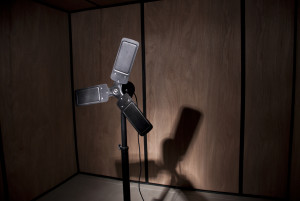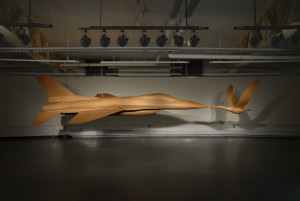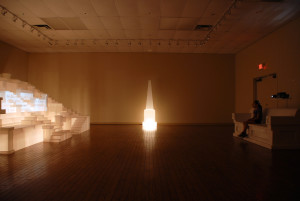The spectator experiences the phenomenon of transmutation; through the change from inert matter into a work of art, an actual transubstantiation takes place….
—Marcel Duchamp
BACK WHEN MY KIDS were very young and I rarely had a moment to myself, I once managed to spend an entire day in SoHo—arguably the epicenter of the international art world then—looking at art, browsing through poetry books, and drinking excellent coffee. At the end of a beautiful afternoon I wandered by the Angelica Film Center and on the spur of the moment went to see the Italian art film Il Postino (The Postman). At this trying stage of my life, in the sleep-deprived pressure cooker of parenting, every moment used to nurture an intellectual and cultural life felt like an indulgence. Directed by Michael Radford, the film was a gem-like tale imagining the poet Pablo Neruda’s fictionalized visit to a small Italian island. I was completely entranced by this slow-paced, lyrical movie. It made the hair on the back of my neck stand up. After the movie ended I sat in my seat for some time. Eventually I exited the dark and empty theater onto Broadway’s illuminated sidewalks, dizzied by a new world of poetic possibility. The little self-absorbed chamber of my life had been pried open and transformed.
I once heard someone say of watching movies; “When I go to see a movie I don’t want to be entertained. I want it to change my life. And I don’t think that’s too much to ask.” That’s not too much to ask of Radford’s film, and it is exactly what Dayton Castleman demands of his art.
He works primarily in a medium one might call sculpture—though the nineteenth-century sense of the term does not quite apply. A nuanced understanding requires that his art be seen within a contemporary context. A brief discussion of art-historical background will show that Castleman’s installations gain their profundity through adroit cultural critique embodied in poetic spectacle.
Castleman’s work is situated in what Rosalind Krauss calls “the expanded field.” In her seminal 1979 essay “Sculpture in the Expanded Field,” she argued that modernist and pre-modern notions of sculpture in the West were embedded in the idea of “monument.” An object is placed on a pedestal and set apart from its environment, yet it typically commemorates that place (or a person or event) through a symbolic language. Krauss showed that in the late twentieth century, a new conception of art and sculpture emerged, in which the traditional boundaries became malleable and art was no longer separated from its environment but became part of it, endowing a space with new meanings.
This movement off the pedestal was made possible by an earlier development in the history of painting. Paintings in the West were long seen as windows that you looked through. The painting was a theatrical stage curtained off by a frame, and the paint itself like an invisible scrim that dissolved as the viewer was drawn in. But by the time of Manet, the paint, no longer content to be invisible, began to assert itself. This process evolved and ultimately was distilled by Picasso, who not only allowed the paint to be paint, but even called attention to the canvas. No longer a stage for an illusionist’s sleight of hand, the canvas became a petri dish for the artist’s systematic investigations.
For Castleman, the dissolution of these historic conventions—veils of paint, framed canvas stages, specimens on pedestals—set the scene for his renewed kind of illusion, one that is self-aware and self-revealing. A puckish spirit energizes his practice, in which both artwork and artist desire to step outside these controlling boundaries. His artworks have escaped their modernist cages, and now, untamed and unruly, they lure us into their shadowy lairs—and they are peering back at us.
Castleman’s first large site-specific installation, The End of the Tunnel (2005), was a public art project awarded by the Eastern State Penitentiary Historic Site in Philadelphia, a nineteenth-century panopticon that has been preserved as a historic monument and serves as a cultural and art venue. A panopticon is a type of prison based on a design by the late-eighteenth-century philosopher Jeremy Bentham, in which inmates are observable by guards at all times, but the inmates cannot see their warders. Bentham’s idea was analyzed as a cultural metaphor by the philosopher and cultural theorist Michel Foucault in his influential 1975 book Discipline and Punish. Foucault’s observations, in particular on the abusive power of the gaze, heavily influenced a generation of cultural critics and art theorists. Castleman deftly harnesses this loaded context and with a minimal gesture transforms our perspective of the site.

PLATE 6. Dayton Castleman. The End of the Tunnel, 2005. Steel pipe and fittings, paint, wood, hardware. Site-specific installation at Eastern State Penitentiary Historic Site, Philadelphia, Pennsylvania. All photos by the artist.
Hundreds of feet of steel plumbing pipe and fittings, painted bright red, snake and probe through the prison. The pipes embody the prisoner desperately searching for a way to penetrate his engineered solitude. Through their frenetic, disjointed search, the hollow pipes metaphorically incarnate the designed isolation—born of the enlightenment and built by modernism. As the viewer wanders around the site, following the erratic twists and turns of the pipes, she begins to adopt their disoriented and disorienting point of view. The pipes are a three-dimensional line drawing—a schematic of escape—mapping alternative routes to freedom. Peering around corners, shooting down service corridors, jutting through holes in the mortar, the plumbing itself cries out that there must be more. The crisscrossing paths become more frantic as the viewer follows them until they eventually disappear—only to reemerge in chorus, having burrowed through the prison yard [see Plate 6]. Together they rise to periscopic heights, finally scaling the thirty-foot barrier to break through the imposed illusion of isolation.
Only here, where the liberated pipes reach a point of transcendence, can the piece be seen from outside the prison. Finally able to see beyond the imposed quarantine, they can now look back into the site of captivity and face down their previously concealed captors. The point of view inverted, they can now observe the observers. But instead of looking down on the ramparts of spiritual confinement (be it a prison, a view of history, art confined to a museum) they look beyond, to the redemption found in the quotidian activities of the world beyond.
Having traversed these barriers, the pipes become a metaphorical conduit, transmuting banal objects through art’s power to arrest our attention. On initially encountering the work, the viewer is captivated by the progression, tracing the physical and intellectual lines. But then the artwork audaciously escapes our scrutiny and its own environmental and cultural confinement, and releases our attention from the artwork itself back onto our own physical, cultural and spiritual confines. The pipes map a means of transcendence, and they beckon us to follow.

PLATE 7. Dayton Castleman. Negative Matter, 2011. Industrial stroboscope, high-velocity fan, motion detector, metal studs, Lauan plywood, hardware. 8 x 20 x 10 feet.
This early installation presages Castleman’s ongoing concerns. His sculptures are embodied investigations of point of view, the power of seeing and believing, and the metaphor of illusion. These three concerns converge powerfully in his 2011 piece Negative Matter [see Plate 7]. The piece is quite simple. Sitting within the gallery is a ten by twenty-foot plywood room, eight feet high, with a single entry point. Standing outside, the viewer hears a deep and resonant hum which grows in intensity as she approaches the threshold, where she also begins to feel a faint breeze emanating from the enclosure. Upon entering the dim interior she is faced with a strong wind and a large, industrial fan, starkly lit by a single light source. The fan’s three large blades are ominous, but unmoving. Gale-force winds and an industrial roar reverberate in this sensory echo chamber, but their source is undetectable. The sparse environment offers only one suspect—the motionless fan—and the space yields no further clues.
The fan has an artistic precedent. Marcel Duchamp enacted a major revolution in art a century ago with his “readymades”—everyday, unaltered, manufactured objects such as a snow shovel or a porcelain plumbing fixture, displayed as art. He also combined pairs of manufactured objects, most famously a bike wheel atop a wooden stool, into what he called “assisted readymades.” This understated act was transformational. He drew the viewer’s eye away from the artist’s technical virtuosity and focused it on the cultural mechanisms of art—including the viewer’s required complicity. A thing must be seen and received as art for it to function as art.
Castleman’s industrial fan stands as a readymade Duchampian cultural quote, yet it is assisted in a way that is harder to see, and more expansive. Duchamp’s readymades revealed the artist’s role as cultural creator, rather than strictly a cobbler of objects. They also empowered the viewer as an active participant in the making of art, rather than a powerless bystander. While Duchamp’s readymades allude to the world outside (the shoveling of snow, the riding of a bike), they ultimately submit to the viewer’s gaze and remain entrenched within the confines of the gallery. Art remains art, born of the artist’s mind, even if not delivered through the facility of the artist’s hand.
Castleman employs a manufactured object and transforms it by placing it within an art context, but the viewer is engaged in a different way. The fan resists passive objectification and responds forcefully, quite literally pushing back at the viewer’s gaze. Unblinkingly staring us down, it dares us to step up and touch the seemingly immobile blades. Yet to do so would cost a finger. Not evident to the eye, the light source illuminating the fan is a finely calibrated stroboscope, exactly in phase with the rotation of the blades. The strobe operates at very high frequency, its pulsing is undetectable to the human eye. The high-velocity fan blades appear frozen, but the power of the illusion in no way subdues the power of the fan. In fact the mental schism enhances it. The perceived stillness amplifies the high-voltage energy of the fan and turns it back on the viewer.
This is a symbolically rich object lesson that seeing is in fact not believing. Or more precisely, that belief must be built upon a foundation deeper than what is evident to the eye. Castleman transforms vision into a resonant metaphor alluding to the nature of human knowledge and the limits of our empirical investigations. Trying out one’s theory can be costly. There are clear signs of the truth that lie beyond sight. Each viewer confronts this seemingly docile, quixotic giant and faces down the driving wind and deafening roar. Castleman puts the viewer’s senses through a stress test in order to reveal something profound about the human heart. When you exit the empirical cacophony of the enclosure into the stillness and quiet, only then can you hear that small voice that transcends the contradictions of logic—that informs what you will believe.

PLATE 8. Dayton Castleman. Starcross’d Lovers, 2009. Cardboard, foam, wood, hardware. 5 x 14 x 23 feet.
Castleman’s earlier work Starcross’d Lovers (2009) is, in an odd way, a more traditional sculptural object. A fabulously crafted, one-third-life-size F-14 fighter jet constructed out of corrugated cardboard is suspended nose-to-nose with an equally alluring three-times-life-size cardboard goose [see Plate 8]. The work was inspired by the emergency landing of a jetliner in the Hudson River in January of 2009 caused by a flock of geese. The confrontation of nature and machine is frozen in an aesthetically charged moment of attraction. The pair are reminiscent of Adam and God on the ceiling of the Sistine Chapel, but instead of the transmission of life and creative energy, this poignant moment points to imminent destruction, a tragic attraction. Still, despite its energy and audacity, the piece is less powerful than Castleman’s other large works. The objects gaze at each other, frozen in a self-referential reflecting pool while the viewer, though awed by the spectacle, remains outside.
This contrasts with Coin (2013), a large installation made for the Art Center of the Ozarks in Springdale, Arkansas, near the home of early twentieth-century eccentric economist and doomsday prophet William Hope “Coin” Harvey. Harvey forecast a calamitous economic crash and a resulting apocalypse. He built an amphitheater in a nearby valley that was to serve as an entrance to a 130-foot solid concrete pyramid which was to contain all the information survivors would need to rebuild society. The pyramid and the apocalypse both went unrealized, but Harvey’s amphitheater and journals survived. The amphitheater’s original purpose is now submerged not only in the murky depths of history, but also in the watery depths of Beaver Lake, created by Beaver Dam in 1966.

PLATE 9. Dayton Castleman. Coin, 2013. Corrugated plastic, plastic mounted slides, slide projector, incandescent lights, dimmer system, wood, hardware. Texts and images from William H. Harvey’s The Pyramid Booklet, The Book, and Common Sense.
Castleman built a scale model of Harvey’s amphitheater out of a translucent corrugated plastic that can be illuminated from within to create an ethereal, spectral presence [see Plate 9]. It also serves as a screen for projected images. The stepped, faceted construction causes the projected images and text to fracture and deconstruct as the viewer moves around. It is only while sitting on the oversized wooden couch (a reproduction of the original concrete bench, now submerged) that the image resolves. The artist thus creates a dialogue between the viewer and the art. Depending on the spectator’s vantage point, the projected journal texts and images are either a cubistic abstraction or a coherent portrayal of the man. A portrait of Coin Harvey emerges from the spectral presence of his design. Both man and object have something to say, if you are willing to sit down and join the conversation.
History proves over and over again that ideas have consequences—as does art. It is no mistake that our artistic heritage, as well as our contemporary vanguard, are protected in guarded fortresses we call museums. Art is one of our culture’s most exquisitely valuable (and expensive) commodities. Art is costly. Film director Michael Radford seemed to have understood this. Before filming Il Postino he was diagnosed with a heart ailment, but he delayed surgery in order to finish the project. The day after filming was complete, he died of a heart attack.
Nobel-winning poet Czeslaw Milosz speaks to the spiritually precarious state of the artist in his poem “Ars Poetica?” Reflecting on the artist’s lack of control over the muse’s dictations, he asks how the artist, driven to create, can discern the spirits and save her soul. He concludes the brilliant poem with this humble stanza:
What I am saying here is not, I agree, Poetry,
as poems should be written rarely and reluctantly,
under unbearable duress and only with the hope
that good spirits, not evil ones, choose us for their instrument.
Art is a perilous business yielding spiritual consequences. Castleman confronted this reality as a young man. At the age of twenty-six and recently married, he was diagnosed with an advanced brain tumor. He, too, faced his own mortality. Any chance of survival required emergency surgery, but the outlook was grim. Miraculously, he survived and maintained his full faculties, but as an artist he was changed. After having their lives so thoroughly shaken, some might abandon the seemingly inconsequential endeavors of a lonely artist in favor of a more “meaningful” occupation, but the “unbearable duress” of calling is a powerful force.
Prior to his surgery he was a fairly traditional painter of realistic illusions. After his recovery he saw an inherent contradiction between the concepts of realism and illusion. No longer content to make stylized facsimiles, he was compelled to make, in his words, “real things.” Gone was the analytical painter stepping back to observe and catalogue; his art became a sacramental act of stepping in to engage, and a site for transformation. Dayton Castleman is possessed with a spirit of inquiry and his work probes below the surface, reaching for a more abiding truth. Life changed his art, and, as it is wont to do, art changed his life. Transfigured, it jumped off the pedestal and escaped the canvas. It is loose out there, peering back at us. It is potentially dangerous. And it is very good.





